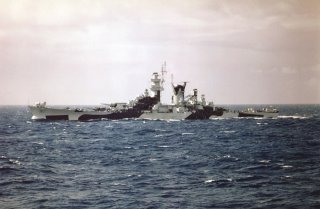The Alaska-Class Battlecruiser War Not Quite a Battleship
Even worse, these ships essentially arrived in time to meet a threat that no longer existed.
While Alaska wasn’t even a state at the time, the United States Navy developed a new class of warship named in honor of the then-territory. All six of the subsequently planned vessels were to be named after territories or insular areas of the United States and the reason was somewhat fitting in that these weren’t battleships nor were the ships actually cruisers. They were essentially a new—and unchartered—territory in warship design.
Their career was also cut short, with the ships’ service spanning less than three years.
The origin of the Alaska-class begins in the 1930s when Nazi Germany developed a class of large yet fast cruisers that the British Royal Navy dubbed “pocket battleships.” The U.S. Navy sought to counter those warships—which were an intermediate class of warships between the larger battleships and the smaller heavy cruisers—with the Alaska-class. The development of this new class of warship had actually lingered on the drawing board until the U.S. Navy responded to the rumors that Japan was building its own “super cruisers.”
President Franklin D. Roosevelt has been credited with supporting the program, which was thus created as much from politics as from true wartime thinking.
Designed to prowl the oceans and hunt down enemy commerce raiders, these “battlecruisers” possessed high speed and considerable firepower—but yet weren’t powerful enough and lacked the armor protection to take on actual battleships. Critics of the vessels have suggested they were both state of the art and obsolete at the same time.
USS Alaska (CB-1) entered service in June 1944, while her sister USS Guam (CB-2) joined the fleet a few months later. A third ship in the class, USS Hawaii (CB-3), was laid down and still under construction when the war ended, while the three additionally planned vessels were subsequently canceled.
By the time the first two U.S. Navy battlecruisers entered service, the German Navy was all but completely destroyed and the Imperial Japanese Navy was on the ropes.
The Alaska-Class in Wartime
Displacing nearly 34,253 long tons under full load, the Alaska-class was slightly on the large end for cruisers but was by no means a battleship. The ships essentially arrived in time to meet a threat that no longer existed.
They were fitted with nine 12-inch/50 caliber Mark 8 naval guns, a barrel size not actually used by the U.S. Navy in three decades; however, it was a new breed of naval cannon. It was able to fire special “super heavy” shells that offered performance slightly superior to that of the older battleships mounting 14-inch naval guns. The Mark 8 was actually considered the most powerful naval gun of the war in terms of size.
The Alaska-class was designed to resist cruiser guns though it lacked the armor of the larger battle wagons. Additionally, the vessels were designed without a torpedo defense system. Yet, what the ships lacked in armor and protection they made up for in speed as the ships could achieve up to 33 knots, which allowed them to keep pace with carriers. However, the length of the battlecruiser and its single rudder meant it had a large turning radius of 800 yards, which wouldn’t have been ideal in combat.
Fortunately, they weren’t actually put to the test.
Neither Alaska nor Guam ever actually faced Japanese battlecruisers in combat, and both ships served largely in support of U.S. landings and escort roles. During the summer of 1945, the two ships conducted several shore bombardment missions, and when the war ended provided assistance in the transfer of power of Korea from Japanese to Allied forces. Both ships participated in Operation Magic Carpet, the repatriation of American forces.
The two battlecruisers were decommissioned in February 1947 and remained in the reserve fleet in New Jersey until the 1960s, when each was broken up for scrap. The third ship of the class, the unfinished USS Hawaii was briefly considered for conversion to a guided-missile cruiser and later to a command ship but never project moved forward. The incomplete ship was scrapped in 1959.
Peter Suciu is a Michigan-based writer who has contributed to more than four dozen magazines, newspapers and websites. He regularly writes about military small arms, and is the author of several books on military headgear including A Gallery of Military Headdress, which is available on Amazon.com.
Image: Reuters

